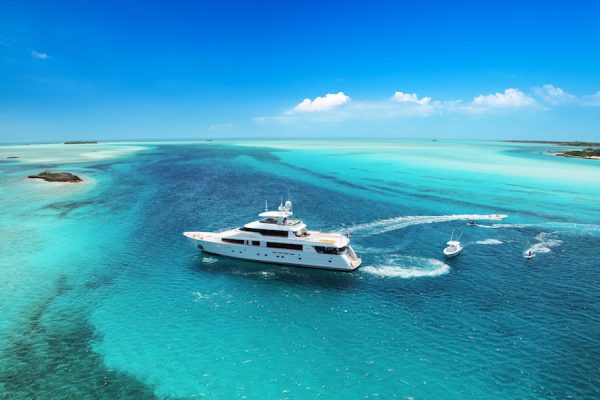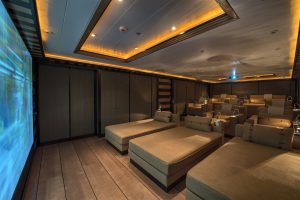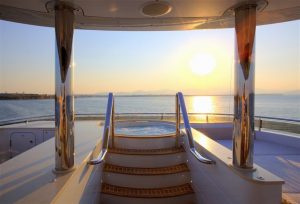
Booking a motor yacht charter isn’t quite a simple as picking one that looks good on the internet.
There are thousands of charter yachts available, and there’s a great deal to know about how choosing the right (or wrong) kind of luxury yacht for your holiday or corporate charter can really impact on your enjoyment.
A professional yacht charter broker will be able to lend their expertise to helping you find the perfect yacht for your vacation. However, to narrow things down, it’s a good idea to know the basic guidelines in choosing a motor yacht charter, from hull design and stability through to onboard amenities and the importance of having the right crew.
Choose the right hull type for speed and comfort
This may sound boring, but it is incredibly important. Few new charterers realize just how much the hull design of the motor yacht they choose can impact on their charter, as hull form dramatically affects the yacht’s speed, running costs, and stability.
There are four types of motor yacht hulls:
- Full displacement yachts: Slow and stable.
 This is a very common hull type in larger yachts, offering cruising speeds of 10-12 knots and a comfortable ride. This is because the hull sits heavy in the water, displacing the water and creating stability.
This is a very common hull type in larger yachts, offering cruising speeds of 10-12 knots and a comfortable ride. This is because the hull sits heavy in the water, displacing the water and creating stability.
- Planing yachts: Very fast, less stable, higher fuel costs.
This hull type uses its powerful engines at the rear to lift up the yacht’s bow above the water, thereby reducing drag and enabling high speeds up to 50 knots. This sporty type of yacht is significantly less stable than full displacement, but this can be improved by chartering a yacht with good stabilizers. Remember, when you charter a high speed planing yacht you’ll pay a lot more in fuel costs.
- Semi-displacement: Medium speed, medium stability.
This sits between the two hull types, giving faster speeds than displacement (around 20 knots) but losing a little of the stability in the exchange. Again, stabilizers will improve the comfort of the yacht. If you’re wanting to avoid rocking at anchor, choose zero-speed stabilizers, also known as at-anchor stabilizers.
- Fast displacement: Fast, fuel efficient, stable, new.
Affording speeds up to 30 knots and enviable stability and fuel efficiency, this revolutionary Fast Displacement Hull Form (FDHF) is only found on fairly new yachts such as the award winning Galactica Star and Galactica Supernova.
Think hard about the cabin layout
 It’s all too easy to fall for a gorgeous looking yacht because the design really floats your boat, but it’s really important to think about how your group will use the yacht, particularly regarding its accommodation layout.
It’s all too easy to fall for a gorgeous looking yacht because the design really floats your boat, but it’s really important to think about how your group will use the yacht, particularly regarding its accommodation layout.
Most charter yachts will accommodate anywhere from 6 to 12 guests, normally based on a two person per cabin arrangement, whether in double or twin berths.
If you want to bring more than 12 guests on board, you will be limited to the few superyachts with commercial passenger licenses, and you’ll definitely need to speak to a charter broker before you start hunting for the perfect yacht.
Think carefully about how the cabins will be assigned within your group. If it’s a family charter, will the teenage children be happy sharing? If it’s a corporate charter, is there enough privacy in shared cabin arrangements for your clients or employees?
If you’re sharing the cost of a charter with another family or friends, think beforehand about which couple will get the master suite, and if you think cabin allocation might cause tension, chat to your charter broker about finding a yacht with comparable sized master and VIPs or convertible cabins.
Pick the right yacht for the cruising ground
The location you want to cruise in should determine the type of yacht you charter. There are yachts that are more suited to some areas than others—or at the very least, they’ll ensure the most cruising enjoyment of that place.
The Bahamas is a great example, as deep draft yachts can’t navigate the shallow waters and reefs, meaning that you’ll be limited to the deeper channels and won’t be able to drop anchor close to the beach and swim ashore.
Also think about the convenience of refueling frequently if you’re using a lot of fuel in a sports (planing) yacht. Is the place you’re visiting well equipped for yachts with fuel docks at well-spaced marinas? Established yachting areas like the French Riviera are great for sports yachts; remote cruising in the Pacific is not.
Are there long passages in between destinations? If so, a full displacement yacht will be both more comfortable and more economical than a planing yacht, and also talk to your broker about prevailing weather patterns and swell conditions in the area so that you can select the yacht with the right stabilization system.
Think about the amenities and crew skills that matter to you
 The onboard facilities and specialist crew skills can really make a difference to your motor yacht charter experience. For example, couples on a honeymoon charter will almost certainly want a yacht with a Jacuzzi, and possibly a spa and/or onboard masseuse for that extra level of indulgence.
The onboard facilities and specialist crew skills can really make a difference to your motor yacht charter experience. For example, couples on a honeymoon charter will almost certainly want a yacht with a Jacuzzi, and possibly a spa and/or onboard masseuse for that extra level of indulgence.
Families will also find the Jacuzzi useful to keep the kids happy on days where the yacht is underway or the sea conditions aren’t ideal, and should look for a yacht with a swim platform, an extensive range of watertoys, and a large selection of onboard movies and games.
Also speak to your broker about special skills the crew have. For instance, foodies will want to seek out an award winning chef, many yachts carry dive or fishing instructors as part of their crew, and some yacht crews are famous for being particularly family friendly or throwing spectacular theme nights or glamorous beach barbeques.
Your charter yacht broker is the only way you can find out this insider information about each yacht on the market. So ask them.
By knowing a little bit about the different kinds of yachts, you can provide your broker with the information they need to match you with the perfect motor yacht charter.